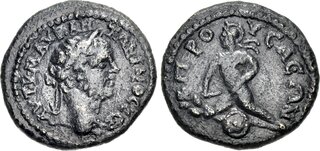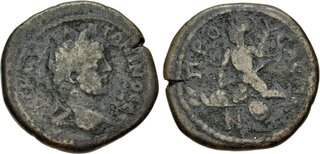Match 1:
Match 2:
| Leu Numismatik AG > Auction 15 | Auction date: 1 June 2024 |
| Lot number: 187 Price realized: This lot is for sale in an upcoming auction - Bid on this lot  | |
| Lot description: LYDIA. Sardis. Caracalla, 198-217. Medallion (Bronze, 42 mm, 33.48 g, 11 h), Loukios Kornelios Vettenianos, strategos and asiarch for the fourth time, circa 205-209. AY•KAI•M•AY•AN-TΩNЄINOC• Laureate and cuirassed bust of Caracalla to right, wearing aegis and balteus. Rev. ЄΠΙ ϹΤΡΑ•ΚΟΡ•ΟΥЄΤΤΗΝΙΑΝΟΥ•ΑϹΙΑ•Δ // ϹΑΡΔΙΑΝΩΝ•B• / ΝЄΩΚΟΡΩΝ Septimius Severus, on the right, standing front in military attire, head to left, holding spear in his left hand and sacrificing with his right over lit altar in front of cult statue of the Kore of Sardis, veiled and draped, standing facing, with grain ears on the left and poppy on her right. GRPC -. Imhoof-Blumer, Lydia -. RPC V.2 online (forthcoming) -. SNG Copenhagen -. SNG Leypold -. SNG München -. SNG von Aulock -. Unpublished and unique. A beautiful medallion with a wonderful portrait and an exceptionally detailed aegis. Light roughness and with minor doubling on the reverse, otherwise, very fine. From a Swiss collection, formed before 2005. Next to the balteus, the body belt or sword suspension of the Roman gladius, the wonderfully crafted bust of the emperor on this unpublished medallion is also adorned with an exceptionally detailed Aegis. Caracalla wears Athena's magical goat-skin shield attached to his left shoulder, from its edges twisting serpents emerge, and the enemies of the emperor (and thus of the empire) are additionally repelled by a terrifying Gorgon head ready to petrify them into stone. The medallion was minted under the strategos and asiarch Loukios Kornelios Vettenianos and likely dates to the years 205-209, as the series includes issues of the entire imperial family, namely Septimius Severus, Julia Domna, Caracalla as Augustus, and Geta as Caesar, but not of Plautilla (202-205). Interestingly, the distinctive curly beard of the emperor on the reverse indicates that this is not Caracalla, but rather his father, Septimius Severus. Estimate: 1500 CHF | 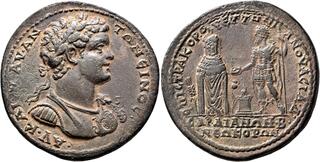 |
Match 3:
| Classical Numismatic Group > Auction 126 | Auction date: 28 May 2024 |
| Lot number: 461 Price realized: This lot is for sale in an upcoming auction - Bid on this lot  | |
| Lot description: CILICIA, Tarsus. Maximinus I. AD 235-238. Æ (36mm, 23.63 g, 1h). Radiate, draped, and cuirassed bust right, seen from behind / The Judgement of Paris: Paris seated left on rock, wearing Phrygian cap and holding apple and pedum, facing Aphrodite, nude, standing right, drawing drapery from shoulders, veiled Hera enthroned right, and Athena standing right, resting shield on ground before her and holding spear. SNG BN 1587 (same dies); RPC VI Online 7109.10 (this coin); SNG Levante –; Cornell 117 (this coin). Earthen red-brown patina, slight roughness. VF. Rare. From the Hesiod Collection. Ex Historical Scholar Collection (Heritage 3101, 25 August 2022), lot 32073; David Simpson Collection (Triton V, 15 January 2002), lot 1755; Classical Numismatic Group XXIV (9 December 1992), lot 497. Before the birth of her second son, Hekaba, wife of King Priam of Troy, dreamed that she had brought forth a flaming firebrand that destroyed the city, and the new-born child was therefore exposed on Mount Ida. Brought up by a shepherd, he was called Paris, and later, by his courage, earned the name Alexander or 'defender of men'. He was beloved by the nymph Oenone, but he deserted her as a result of a tempting suggestion by Aphrodite which led to the Judgement of Paris. When Hermes came to Mount Ida with the three goddesses he called Paris and said to him: "Come here and decide which is the more excellent beauty of face, and to the fairer give this apple's lovely fruit." (Colluthus, The Rape of Helen 130). While Paris reflected, the goddesses, who for the occasion had bathed their immortal bodies, offered him bribes in order to win the apple award of beauty: Athena offered him the command of Phrygia and the destruction of Hellas, or as some say, that he would be bravest of mortals and skilled in every craft. Likewise Hera offered him, besides wealth, the dominion over Asia and Europe. But Aphrodite offered him the hand of Helen, whose beauty was famous worldwide, and this bribe won the apple. Estimate: 2000 USD | 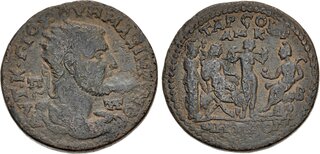 |
Match 4:
| Classical Numismatic Group > Auction 126 | Auction date: 28 May 2024 |
| Lot number: 452 Price realized: This lot is for sale in an upcoming auction - Bid on this lot  | |
| Lot description: CARIA, Stratonicaea. Caracalla, with Geta as Caesar. AD 198-217. Æ (36mm, 26.35 g, 6h). Damnatio Memoriae. Zosimus II, grandson of Posittus, prytanis. Struck under Septimius Severus, circa AD 198-202. [Bareheaded and draped bust of Geta] vis-à-vis laureate, draped, and cuirassed bust of Caracalla; c/ms: helmeted head of Roma within circular incuse, and ΘEOY within rectangular incuse / Hecate standing facing, head left, wearing calathus, holding patera and torch; at feet left, dog standing left, looking right. SNG von Aulock 2692. For c/ms: Howgego 188; 536. Brown patina, scrape on reverse, small flan crack. Good VF. Portrait of Geta erased, Caracalla's damnatio memoriae of Geta applied after his murder in AD 211. Upon Septimius' passing in AD 211, his sons Caracalla and Geta assumed joint rule of the empire. Their joint rule was a failure, the Imperial Palace was separated into two sections and they threatened to divide the empire between them. During the Festival of Saturnalia, December 211, Caracalla tried unsuccessfully to have his brother assassinated. But a week later, at an arranged meeting in their mother's quarters, Geta was murdered by Caracalla's centurions. Caracalla immediately ordered a damnatio memoriae of his brother's image: statues were removed, paintings were destroyed or, like the Severan Tondo erased, and coins were recalled to have his image carved out. This damnatio was especially apparent on the provincial coinage of Pergamum in Mysia and Stratonicaea in Caria. It is estimated that approximately 95% of the dual bust types at Stratonicea have had the portrait of Geta erased, many of them having a countermark of Roma or Caracalla stamped over his bust. Estimate: 500 USD | 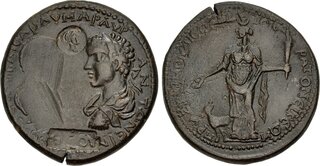 |
Match 5:



